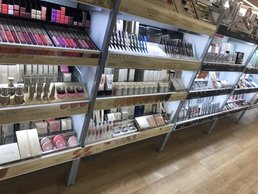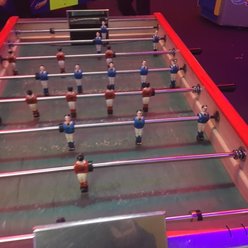Senior Pranks
By: Katelyn Bohn

Senior pranks, a common high school ritual practiced by soon-to-be graduates, have a more negative affect than some people might expect. Although most Seniors go into these pranks without a harmful intent, sometimes the outcome of the prank can’t be predicted, or a more innocent joke gets taken too far, resulting with student harm or targeting the prank towards a particular victim. Unfortunately, when a prank proceeds in such a manner, it can end up tainting the Senior graduation and instilling bad memories for not only those involved, but the entire school as a whole.
At South Iredell High School, in Statesville, North Carolina, The Huffington Post details a perfect example of a senior prank gone wrong. Alarm clocks hidden by Seniors in unused lockers, originally closed off with zip ties by the school staff, now had been cut and had locks fastened on them. They set the clocks to go off every few minutes, leading teachers and students to suspect the worst; that bombs had been hidden throughout the school, thus ensuing the evacuation of 1500 students and teachers. It ended with the student arrests, which could have easily been avoided without the prank’s invention.
Mr. Wight, Principal of Apex Friendship High School, says this about Senior pranks: “I’ve had good and bad experiences with the Senior pranks… there have been some that have been very destructive, and almost bordering on vandalism… people see all kinds of crazy things on YouTube, and they think, ‘Oh, that’s a great idea’... and then somebody gets hurt or killed, and it’s not so funny anymore.” Mr. Wight explains that he had a Senior gift at his previous school, which he described as a meaningful symbol of Senior spirit, and he says that he will consider doing a spirit rock next year for the 2018 Senior class. “I wouldn’t want any of our kids to get hurt, and I wouldn’t want anything to happen that would tarnish the Senior class graduation.”
Although there have been many consequences to Senior pranks listed in this article, I understand why some students may view it as a good idea at first glance. It portrays students as fun and clever if they come up with an original idea that everyone can partake in, but it has more risk than reward, like trying to win a dangerous lottery. Seniors never know if the prank will go South until it does, and they end up endangering themselves or someone else. At most, remember to be wise, and think before acting.
At South Iredell High School, in Statesville, North Carolina, The Huffington Post details a perfect example of a senior prank gone wrong. Alarm clocks hidden by Seniors in unused lockers, originally closed off with zip ties by the school staff, now had been cut and had locks fastened on them. They set the clocks to go off every few minutes, leading teachers and students to suspect the worst; that bombs had been hidden throughout the school, thus ensuing the evacuation of 1500 students and teachers. It ended with the student arrests, which could have easily been avoided without the prank’s invention.
Mr. Wight, Principal of Apex Friendship High School, says this about Senior pranks: “I’ve had good and bad experiences with the Senior pranks… there have been some that have been very destructive, and almost bordering on vandalism… people see all kinds of crazy things on YouTube, and they think, ‘Oh, that’s a great idea’... and then somebody gets hurt or killed, and it’s not so funny anymore.” Mr. Wight explains that he had a Senior gift at his previous school, which he described as a meaningful symbol of Senior spirit, and he says that he will consider doing a spirit rock next year for the 2018 Senior class. “I wouldn’t want any of our kids to get hurt, and I wouldn’t want anything to happen that would tarnish the Senior class graduation.”
Although there have been many consequences to Senior pranks listed in this article, I understand why some students may view it as a good idea at first glance. It portrays students as fun and clever if they come up with an original idea that everyone can partake in, but it has more risk than reward, like trying to win a dangerous lottery. Seniors never know if the prank will go South until it does, and they end up endangering themselves or someone else. At most, remember to be wise, and think before acting.
Teen Health Deserve more attention
By: Julia Uhlman

Our health as teens happens to be incredibly important, but remains overlooked too often. Good health in the teenage years happens to be crucial for healthy development into adulthood and deserves more attention.
Health in high school sets the stage for the future, and as of now, the outlook for teenagers could be improved. To combat these issues, I advocate later start times, less homework, and a greater emphasis on the importance of mental health.
Sleep deprivation happens to be among the most common issues teenagers face, and can lead to more health issues than it seems. During the high school years, teens sleep patterns naturally shift toward staying up later and sleeping in later. Since teens need 8 to 10 hours of a sleep a night, this necessary sleep happens to be extremely hard to achieve with early school start times. Healthcare.utah found that over 90% of high schoolers prove to be chronically sleep deprived. The National Institute of Health discovered 20% of teens get less than 5 hours of sleep a night. A majority of teens do not get the necessary amount of sleep in the most critical developmental stage of their lives. Sleep deprivation can cause a number of health issues, including stress and other mental health risks.
Mental health remains an issue brushed over too frequently. The results of poor mental health can be detrimental, especially in teenage years when teens develop and find themselves. Stress, anxiety, depression and suicidal thoughts happen to be frequently associated with high schoolers. As seen in the popular Netflix show, 13 Reasons Why, poor mental health can have some tragic results. Watching what one says happens to be so important, as well as thinking before one speaks or acts.
Health in adolescence remains more important than society makes it seem, and the effects of poor health can be carried with teens for the rest of their lives.
Health in high school sets the stage for the future, and as of now, the outlook for teenagers could be improved. To combat these issues, I advocate later start times, less homework, and a greater emphasis on the importance of mental health.
Sleep deprivation happens to be among the most common issues teenagers face, and can lead to more health issues than it seems. During the high school years, teens sleep patterns naturally shift toward staying up later and sleeping in later. Since teens need 8 to 10 hours of a sleep a night, this necessary sleep happens to be extremely hard to achieve with early school start times. Healthcare.utah found that over 90% of high schoolers prove to be chronically sleep deprived. The National Institute of Health discovered 20% of teens get less than 5 hours of sleep a night. A majority of teens do not get the necessary amount of sleep in the most critical developmental stage of their lives. Sleep deprivation can cause a number of health issues, including stress and other mental health risks.
Mental health remains an issue brushed over too frequently. The results of poor mental health can be detrimental, especially in teenage years when teens develop and find themselves. Stress, anxiety, depression and suicidal thoughts happen to be frequently associated with high schoolers. As seen in the popular Netflix show, 13 Reasons Why, poor mental health can have some tragic results. Watching what one says happens to be so important, as well as thinking before one speaks or acts.
Health in adolescence remains more important than society makes it seem, and the effects of poor health can be carried with teens for the rest of their lives.
Women in the workplace
By: Jada Enoch
Photo by: Riley Smith

Through time, women continue to make a steady increase towards total gender equality, but much more needs to be done in order to accomplish this goal. A pay gap reflects the difference in men’s and women’s median earnings. In 2015 the IWPR documented a 20% pay gap between men and women in the workforce. A female’s pay has grown exponentially since 1960, but it won’t reach the even level of the average males until approximately 2059.
Women make 80 cents for every dollar made by a man. An interesting aspect of this gap shows it affects a wide variety of ethnicities, races, and religious backgrounds. The numbers depend almost purely on gender, but do negatively vary in cases of Hispanics and African Americans.
Segregation within the work force exaggerates the pay gap. In 2015, there has been a total of 149 million full-time and part-time workers, 53% male and 47% female. There proves an unequal representation of women in construction, maintenance, production, and transportation, while men show little interest in the fields of education, health care, and office and administration support. This separation of job choice strongly contributes to the inequality in salaries, frequently with the result of female dominated jobs having a lower salary average than jobs correlated with men.
For a great example of an obvious pay interval, look at the women’s US soccer team. They stayed nearly undefeated throughout the 2016 Summer Olympics, something the men’s team didn’t qualify for. Earlier this year five star players of the women’s team filed a formal complaint to the Equal Employment Opportunity Commission (EEQC) stating the men’s team gets paid almost 4 times more than them. The women receive a $72,000 base salary in contrast to the males $100,000. The women documented $1,350 for each win and nothing for a tie or loss, compared to $9,375 for a men’s victory, $6,250 for a tie, and $5,000 for a loss. Sadly, if the men win a high ranked game, their bonus goes up. Although this case recently has been published, it doesn’t deviate too far from most occupations in the United States. Many women find themselves in jobs that don’t pay as highly as men.
The true question remains. How do we fix this problem? With girls everywhere fighting to earn as much as men through protests and with companies promoting equality, hopefully we can achieve what we have deserved all along; equal pay for equal work.
Women make 80 cents for every dollar made by a man. An interesting aspect of this gap shows it affects a wide variety of ethnicities, races, and religious backgrounds. The numbers depend almost purely on gender, but do negatively vary in cases of Hispanics and African Americans.
Segregation within the work force exaggerates the pay gap. In 2015, there has been a total of 149 million full-time and part-time workers, 53% male and 47% female. There proves an unequal representation of women in construction, maintenance, production, and transportation, while men show little interest in the fields of education, health care, and office and administration support. This separation of job choice strongly contributes to the inequality in salaries, frequently with the result of female dominated jobs having a lower salary average than jobs correlated with men.
For a great example of an obvious pay interval, look at the women’s US soccer team. They stayed nearly undefeated throughout the 2016 Summer Olympics, something the men’s team didn’t qualify for. Earlier this year five star players of the women’s team filed a formal complaint to the Equal Employment Opportunity Commission (EEQC) stating the men’s team gets paid almost 4 times more than them. The women receive a $72,000 base salary in contrast to the males $100,000. The women documented $1,350 for each win and nothing for a tie or loss, compared to $9,375 for a men’s victory, $6,250 for a tie, and $5,000 for a loss. Sadly, if the men win a high ranked game, their bonus goes up. Although this case recently has been published, it doesn’t deviate too far from most occupations in the United States. Many women find themselves in jobs that don’t pay as highly as men.
The true question remains. How do we fix this problem? With girls everywhere fighting to earn as much as men through protests and with companies promoting equality, hopefully we can achieve what we have deserved all along; equal pay for equal work.
inside scoop on tanning
By: Chase Parsons
Photo by: Braylin Campbell

Planning on trying to get that perfect tan for Prom? Better think twice on a method of tanning. Most people yearn to be super tan, but how much harm can certain tanning methods cause? Tanning beds prove to be the worst form of tanning. They produce both UVB and UVA rays. According to factretriever.com, “UVB rays penetrate the top layers of the skin and are the ones mainly responsible for sunburns. UVA rays penetrate to the deeper layers of skin and are associated with allergic reactions, such as a rash.” Both can cause cancer and lead to skin damage, such as wrinkling and age spots. States like California, Delaware, Hawaii, and Texas, as well as a few others, have made it illegal to use tanning beds under the age of 18. North Carolina does not require parental consent or permission for teens under 18 to use a tanning bed, according to ncsl.org. Some people use tanning beds so much that they become addicted to them. According to shape.com, “Tanorexia is a term that describes a condition in which a person tans excessively to achieve a darker complexion because they perceive themselves as unacceptably pale,” says Dr. Glenn Kolansky, board certified New Jersey dermatologist. More negative than positive results come from tanning beds, so why use them?
“The body makes vitamin D when skin is directly exposed to the sun,” according to ods.od.nih.gov. People need vitamin D which can be obtained from being in the sun, but too much sun exposure can lead to sunburn and even skin cancer. Vitamin D can also be obtained from eating fatty fish or drinking fortified orange juice, according to health.com. Wearing sunscreen with SPF protects the skin from harmful UVB rays. Yes some sun intake in moderation does help the body, but too much proves to be detrimental because of the long lasting negative after effects.
Spray tanning can be used as a non-harmful alternative to tanning beds and sun tanning. Locations like Planet Beach, Sun Tan City, and Bella Tan offer affordable spray tans during prom season. Spray tanning also comes in bottles, sold at most beauty supply stores.
Instead of risking skin cancer with tanning beds or harmful sunburns from sun tanning, use the safer technique of spray tanning. It has many positive aspects, such as a long lasting tan and it can be done quickly. Clearly, spray tans stand out as the best option when trying to achieve the perfect Prom tan.
“The body makes vitamin D when skin is directly exposed to the sun,” according to ods.od.nih.gov. People need vitamin D which can be obtained from being in the sun, but too much sun exposure can lead to sunburn and even skin cancer. Vitamin D can also be obtained from eating fatty fish or drinking fortified orange juice, according to health.com. Wearing sunscreen with SPF protects the skin from harmful UVB rays. Yes some sun intake in moderation does help the body, but too much proves to be detrimental because of the long lasting negative after effects.
Spray tanning can be used as a non-harmful alternative to tanning beds and sun tanning. Locations like Planet Beach, Sun Tan City, and Bella Tan offer affordable spray tans during prom season. Spray tanning also comes in bottles, sold at most beauty supply stores.
Instead of risking skin cancer with tanning beds or harmful sunburns from sun tanning, use the safer technique of spray tanning. It has many positive aspects, such as a long lasting tan and it can be done quickly. Clearly, spray tans stand out as the best option when trying to achieve the perfect Prom tan.
Pet longevity pill: is animal testing worth it?
By: Riley Smith

If you want your dog to live longer, listen up. Your dog's life span could be greatly expanded because of a new pill called Rapamycin, according to CNN. This pill helps cancer patients, but after a decade of using it on mice, research has shown it to have expanded their lifespan by 60%. Rapamycin had been discovered fifty years ago on Easter Island in the South Pacific, and then studied in a Canadian lab. These pills have been known as the most effective in fighting aging that Professor Arlan Richardson at the Reynolds Oklahoma Center may have seen.
The University of Washington’s Dog Aging Project had the pill given to sixteen dogs, and then had their hearts imaged. Their hearts came out looking more youthful. This pill should help your dog’s lifespan by 10%, which will be around two to three more years on their life. Not only will this pill help your dog and how long they live, but it helps fight any inflammation and any growing cancer cells. It could reduce the chances of them catching any age related diseases, and you’ll get more time with them.
According to Time Magazine, the average age for a dog measures around 12 years. Rapamycin, an immunosuppressant, has been showing great progress on the animals in the labs. While this pill doesn’t show any signs of magic in humans, it does keep the animals living longer.
If this pill continues to improve the lives of our furry friends, veterinarians one day may be able to prescribe this pill to the healthy older dogs. Matt Kaeberlein, co-director of the study and professor of pathology at the University of Washington says, “About 70% of dogs that took the highest dose of the drug were also noticeably more active.” The drug has definitely been helping the dogs. Now researchers need to continue the trials, to help tell them whether Rapamycin may keep dogs sharp.
Pet owners will do whatever will help their dogs, but what if that meant supporting animal testing in order for the dog to live longer? Animals deserve to be treated ethically. They may not have a voice, but does that make it right for humans to go ahead and abuse them for our own benefit?
No animal should have to endure the pain and torture of being injected or mishandled for experiments. The knowledge that the pill Rapamycin works came about because of experiments on the dogs, and while this animal testing could work out in the long run, does this make it correct? Animals only deserve to be nurtured and cared for. They shouldn’t be kept in labs to have daily testing done. Think twice when deciding if this pill or any animal tested products merit the money. If the animals have to suffer, then maybe not.
The University of Washington’s Dog Aging Project had the pill given to sixteen dogs, and then had their hearts imaged. Their hearts came out looking more youthful. This pill should help your dog’s lifespan by 10%, which will be around two to three more years on their life. Not only will this pill help your dog and how long they live, but it helps fight any inflammation and any growing cancer cells. It could reduce the chances of them catching any age related diseases, and you’ll get more time with them.
According to Time Magazine, the average age for a dog measures around 12 years. Rapamycin, an immunosuppressant, has been showing great progress on the animals in the labs. While this pill doesn’t show any signs of magic in humans, it does keep the animals living longer.
If this pill continues to improve the lives of our furry friends, veterinarians one day may be able to prescribe this pill to the healthy older dogs. Matt Kaeberlein, co-director of the study and professor of pathology at the University of Washington says, “About 70% of dogs that took the highest dose of the drug were also noticeably more active.” The drug has definitely been helping the dogs. Now researchers need to continue the trials, to help tell them whether Rapamycin may keep dogs sharp.
Pet owners will do whatever will help their dogs, but what if that meant supporting animal testing in order for the dog to live longer? Animals deserve to be treated ethically. They may not have a voice, but does that make it right for humans to go ahead and abuse them for our own benefit?
No animal should have to endure the pain and torture of being injected or mishandled for experiments. The knowledge that the pill Rapamycin works came about because of experiments on the dogs, and while this animal testing could work out in the long run, does this make it correct? Animals only deserve to be nurtured and cared for. They shouldn’t be kept in labs to have daily testing done. Think twice when deciding if this pill or any animal tested products merit the money. If the animals have to suffer, then maybe not.
bunny-free Easter
By: Julia Uhlman
Photo by: Chase Parsons

As an iconic symbol of the Easter holiday, bunnies, with their big ears and cotton tails, often receive a lot of attention. Of the rabbits adopted for Easter, 80% end up abandoned, according to huffingtonpost.com. Caroline Gracie, the head of Main Line Animal Rescue, warns people that, “often after a very short period of time, people abandon them and they end up in shelter or worse.”
Many people fail to realize that rabbits can not be considered a low-maintenance pet. They often require as much care as dogs, and they don’t stay small and cute forever. Rabbits live anywhere from 8 to 12 years. Often, people not willing to care for these animals any longer think that setting them free will be in the best interest of the rabbits. In fact, this action may be one of the cruelest acts a rabbit owner could do. Domesticated rabbits don’t have the instincts of a wild rabbit, and many often die a terrible death.
It goes beyond this. According to the People for Ethical Treatment of Animals (PETA), “these are some of the most abused animals on earth.” Rabbits happen to be unique in that they have versatility from an economic standpoint. They can be used for pets, for their meat, for their fur, and often for laboratory experimentation. Popular makeup brands such as MAC and Maybelline and skincare brands such as Vaseline and Neutrogena continue to test on animals, according to peta.org. Rabbits, along with other animals, suffer many brutal experiments including, “Forced chemical exposure in toxicity testing, which can include oral force-feeding, forced inhalation, skin or injection into the abdomen, muscle, etc.”, according to the Humane Society.
As someone opposed to the horrors of animal testing, I recommend stepping away from products and brands that knowingly torture rabbits and other animals. Brands such as ELF and Burt’s Bees remain cruelty free, among many others. Brands that don’t test on animals use products that have been cleared as safe for use. I also advise you to take into account all the factors that come with owning a rabbit before you adopt. Bunnies should not be mistreated for our benefit; they live and breathe just like humans and deserve better treatment.
Many people fail to realize that rabbits can not be considered a low-maintenance pet. They often require as much care as dogs, and they don’t stay small and cute forever. Rabbits live anywhere from 8 to 12 years. Often, people not willing to care for these animals any longer think that setting them free will be in the best interest of the rabbits. In fact, this action may be one of the cruelest acts a rabbit owner could do. Domesticated rabbits don’t have the instincts of a wild rabbit, and many often die a terrible death.
It goes beyond this. According to the People for Ethical Treatment of Animals (PETA), “these are some of the most abused animals on earth.” Rabbits happen to be unique in that they have versatility from an economic standpoint. They can be used for pets, for their meat, for their fur, and often for laboratory experimentation. Popular makeup brands such as MAC and Maybelline and skincare brands such as Vaseline and Neutrogena continue to test on animals, according to peta.org. Rabbits, along with other animals, suffer many brutal experiments including, “Forced chemical exposure in toxicity testing, which can include oral force-feeding, forced inhalation, skin or injection into the abdomen, muscle, etc.”, according to the Humane Society.
As someone opposed to the horrors of animal testing, I recommend stepping away from products and brands that knowingly torture rabbits and other animals. Brands such as ELF and Burt’s Bees remain cruelty free, among many others. Brands that don’t test on animals use products that have been cleared as safe for use. I also advise you to take into account all the factors that come with owning a rabbit before you adopt. Bunnies should not be mistreated for our benefit; they live and breathe just like humans and deserve better treatment.
Cultural Appropriation
By: Sierra Sanchez

Cultural appropriation, according to Oxford Reference, can be defined as “a term used to describe the taking over of creative or artistic forms, themes, or practices by one cultural group from another.” In 2014, Isha Aran wrote an article for jezebel.com explaining why wearing a bindi, the decorative mark worn on the forehead by many Indian women, to a musical festival can be classified as cultural appropriation. Aran says, “The issue that so many people have with the recent bindi summer festival trend is that it doesn't take from Hindu culture on Hindu culture's terms. It takes from Hindu culture on American terms and negates the Hindu aspect through ignorance and exoticism of an ‘alluring foreign culture.’ Bindi trend-sporters aren't celebrating a cultural symbol. They're celebrating themselves and the thought-of-it-first appeal of disposable fashion.” The problem had been the bindi being treated like a “trend” in American culture without the knowledge of what the bindi represents. According to ancientorigins.net, the bindi, a physical symbol in Hindu culture represents wisdom, spiritual development, and the third eye while addressing dualism like potential and kinetic energy.
Now, how can someone admire another’s culture without appropriating it? Cultural appreciation proves to be the simplest answer. Pysch2go.net defines Cultural Appreciation as “learning about another culture with respect and courtesy. It is appreciating a certain culture enough to take time to learn about it, interact with people among the culture, and actually understand the culture.”
Recently Angelina Jolie has emerged into the public eye with a beautiful form of cultural appreciation. While visiting Cambodia for the premiere of her new film, Angelina Jolie and her children talked with BBC News about culinary excellency of cooking spiders. While many rolled their eyes and stuck out their tongue, others widely appreciated Jolie’s gesture. In Cambodia, eating these creatures ranks as a delicacy. Jolie adopted her eldest son from Cambodia in 2002 and the viral video shows Jolie educating her children on the history and tradition of the Cambodian fried spider. This beautiful act screams appreciation and admiration. When someone takes the time to learn, educate, and fully immerse themselves into a culture, then they cannot suffer from appropriation but thrive from appreciation.
Sophomore Teiari Matthews and member of the BSA (Black Student Alliance, led by Ms. Johnston in room 1206 during A lunch) says, “Cultural appropriation is like plagiarism. Most people wouldn’t copy something offline and get mad when you criticize them, so don’t be shocked when someone becomes angry at you for appropriating someone else’s culture. Like, you’re copying someone, what else do you expect?” AFHS students would benefit from becoming culturally aware and diverse by expanding their knowledge since we live in the “melting pot” of the world. As Kofi Annan once said, “Knowledge is power. Information is liberating. Education is the premise of progress, in every society, in every family.”
Now, how can someone admire another’s culture without appropriating it? Cultural appreciation proves to be the simplest answer. Pysch2go.net defines Cultural Appreciation as “learning about another culture with respect and courtesy. It is appreciating a certain culture enough to take time to learn about it, interact with people among the culture, and actually understand the culture.”
Recently Angelina Jolie has emerged into the public eye with a beautiful form of cultural appreciation. While visiting Cambodia for the premiere of her new film, Angelina Jolie and her children talked with BBC News about culinary excellency of cooking spiders. While many rolled their eyes and stuck out their tongue, others widely appreciated Jolie’s gesture. In Cambodia, eating these creatures ranks as a delicacy. Jolie adopted her eldest son from Cambodia in 2002 and the viral video shows Jolie educating her children on the history and tradition of the Cambodian fried spider. This beautiful act screams appreciation and admiration. When someone takes the time to learn, educate, and fully immerse themselves into a culture, then they cannot suffer from appropriation but thrive from appreciation.
Sophomore Teiari Matthews and member of the BSA (Black Student Alliance, led by Ms. Johnston in room 1206 during A lunch) says, “Cultural appropriation is like plagiarism. Most people wouldn’t copy something offline and get mad when you criticize them, so don’t be shocked when someone becomes angry at you for appropriating someone else’s culture. Like, you’re copying someone, what else do you expect?” AFHS students would benefit from becoming culturally aware and diverse by expanding their knowledge since we live in the “melting pot” of the world. As Kofi Annan once said, “Knowledge is power. Information is liberating. Education is the premise of progress, in every society, in every family.”
Wall of Division
By: Neda Dabbagh
Photo By: Braylin Campbell

Well known for their similar cultures and raging crusade, Palestinians and Israelis have thrived side by side as far back as the 1930’s. However, in the mid 1990’s, a barrier formed in the Gaza Strip, isolating the Palestinians from communicating to the outside world. Later, in 2002, the Israelites constructed a concrete wall that put a final divide in the West Banks. Palestinians became adrift with the dwellings of separated family relationships, loss of homes and the uprooting of their heritage because of the negative impacts of the barrier wall.
The disunion of the Palestinians
duplicates the history of the Berlin Wall and both issues led to disasters in socioeconomics and civilizations struggling to withstand isolation from neighboring countries. It undermines the natural principle of equality and non-discrimination since the wall targets the Palestinian civilians based on where they come from.
Not only does the cement wall contribute to colonial segregation, but also adds to the constant inefficiency of traveling to workplaces in Jerusalem. “95% of Palestinians from the areas ‘outside’ of it and 77% [from] the areas ‘inside’ the wall (relative to Jerusalem) report that they have difficulties getting to their workplace”, exclaims Israeli citizen Bryan Atinsky. The wall prevents civilians from traveling on the main routes through Bethlehem and Ramallah, leading to unemployment for qualified residents. Specified areas such as the Closed Zone require the Palestinian residents to obtain permits that allow them to remain in their own home and travel to work more efficiently. Despite the rulings, an estimate of
75% of Palestinians do not own permits, preventing them from entering in Jerusalem or living in their own homes. Overall, it leads to a decline of job employment and decimates the possible opportunity of allowing Palestinians to return home.
Mayor Barkat of Israel releases pretentious and empty promises. The walls lead to isolation of the Palestinian people from necessary resources, families, religious worship, and medical care. To accommodate these issues, demolishing the wall would lead to a united country with fair laws and regulations. A possibility exists for Israel to focus on both countries in order to enforce equality amongst all.
Without this barrier, Palestinians and Israelis will learn to coexist in the means to prosper as a nation for economic and humanitarian prospects. Bestowing the Palestinian heritage and culture back with residents who lost their homes and family represents a step forward in putting an end to this world wide conflict.
The disunion of the Palestinians
duplicates the history of the Berlin Wall and both issues led to disasters in socioeconomics and civilizations struggling to withstand isolation from neighboring countries. It undermines the natural principle of equality and non-discrimination since the wall targets the Palestinian civilians based on where they come from.
Not only does the cement wall contribute to colonial segregation, but also adds to the constant inefficiency of traveling to workplaces in Jerusalem. “95% of Palestinians from the areas ‘outside’ of it and 77% [from] the areas ‘inside’ the wall (relative to Jerusalem) report that they have difficulties getting to their workplace”, exclaims Israeli citizen Bryan Atinsky. The wall prevents civilians from traveling on the main routes through Bethlehem and Ramallah, leading to unemployment for qualified residents. Specified areas such as the Closed Zone require the Palestinian residents to obtain permits that allow them to remain in their own home and travel to work more efficiently. Despite the rulings, an estimate of
75% of Palestinians do not own permits, preventing them from entering in Jerusalem or living in their own homes. Overall, it leads to a decline of job employment and decimates the possible opportunity of allowing Palestinians to return home.
Mayor Barkat of Israel releases pretentious and empty promises. The walls lead to isolation of the Palestinian people from necessary resources, families, religious worship, and medical care. To accommodate these issues, demolishing the wall would lead to a united country with fair laws and regulations. A possibility exists for Israel to focus on both countries in order to enforce equality amongst all.
Without this barrier, Palestinians and Israelis will learn to coexist in the means to prosper as a nation for economic and humanitarian prospects. Bestowing the Palestinian heritage and culture back with residents who lost their homes and family represents a step forward in putting an end to this world wide conflict.
is it even Soap?
By: Jada Enoch
Photo by: Kierney Leonard
Photo by: Kierney Leonard

Recently, the Food and Drug Administration put new restrictions on bodily cleaners. Antibacterial cleansers have been taken off the market because of two of the main ingredients, triclosan and an endocrine disruptor. These two antibacterial agents have recently been found to be carcinogens. The FDA has given companies a year to remove the agents from the shelves, so in the meantime I recommend avoiding them.
Most substances that people clean their bodies with shouldn’t even be legally labeled as soap. To be a soap, the FDA requires the product to meet three expectations; it must have two main components, alkali salts and fatty acids, because the two combined make the material lye. Information from the FDA website goes hand in hand with meeting the second regulation; these two ingredients can be the only two cleansing agents inside the soap. If any synthetic chemicals occupy the soap, then it can be classified as a synthetic detergent. Technically, this should be referred to as a cosmetic.
It also must be marketed for its purpose. If the soap contains a moisturizer or a medication, it must be listed as one of these categories. Strangely, however, even if the body cleanser does not fit these regulations, it can still have the labeling rights of the term “soap”. Although most choose to label these as washes or detergents, how will we be able to tell the difference?
Bar soaps, the safest to use, also have numerous benefits for the skin. The ingredients in bar soaps contain moisturizers and help against razor bumps post-shave. Unlike synthetic detergents, most liquid cleanser bar soaps can be significantly cheaper despite having natural ingredients.
Mainstream companies such as Neutrogena and Dial shouldn’t be considered safe options just because of their common use. Both of the products from these name brands contain chemicals harmful to human skin, including cocamide DEA (Neutrogena) and PEG- 12 (Dial). In a day and age where people cut corners to make money, it becomes important to be careful with what the ingredients put into skin products include in order to ensure safety and health.
Most substances that people clean their bodies with shouldn’t even be legally labeled as soap. To be a soap, the FDA requires the product to meet three expectations; it must have two main components, alkali salts and fatty acids, because the two combined make the material lye. Information from the FDA website goes hand in hand with meeting the second regulation; these two ingredients can be the only two cleansing agents inside the soap. If any synthetic chemicals occupy the soap, then it can be classified as a synthetic detergent. Technically, this should be referred to as a cosmetic.
It also must be marketed for its purpose. If the soap contains a moisturizer or a medication, it must be listed as one of these categories. Strangely, however, even if the body cleanser does not fit these regulations, it can still have the labeling rights of the term “soap”. Although most choose to label these as washes or detergents, how will we be able to tell the difference?
Bar soaps, the safest to use, also have numerous benefits for the skin. The ingredients in bar soaps contain moisturizers and help against razor bumps post-shave. Unlike synthetic detergents, most liquid cleanser bar soaps can be significantly cheaper despite having natural ingredients.
Mainstream companies such as Neutrogena and Dial shouldn’t be considered safe options just because of their common use. Both of the products from these name brands contain chemicals harmful to human skin, including cocamide DEA (Neutrogena) and PEG- 12 (Dial). In a day and age where people cut corners to make money, it becomes important to be careful with what the ingredients put into skin products include in order to ensure safety and health.
Too much tech
By: Braylin Campbell

From Tamagotchi to tablets, children’s way of play has evolved tremendously. Through the years, entertainment for children tends to be more simplistic than today. Children previously found toys such as yo-yos, skip its, and Pokémon balls, that provided fun for hours. Now, children either spend their time on video games or tablets to get the fun they want.
According to associationsnow.com, out of the 1,000 parents surveyed, 59% said their child has access to a tablet, 52% have smartphones, and another 52% have video game consoles. Technology has pros and cons. The use of technology positively helps people in terms of being updated with the world around them. Programs such as ABC Mouse can improve kids knowledge.
Technology can also stimulate thinking skills, problem solving, and helps the child learn how to properly navigate the technology in use. These uses can also increase an interest in many technological hobbies that’ll possibly turn into jobs.
Though technology has positives, it also has negatives. According to associationsnow.com, with the overuse of technology, kids tend to lose interest in other activities. Rather than spending their time outside, children all around the world tend to be consumed in whatever video game or video they are playing or watching. Children will begin to live sedentary lifestyles, which leads to poor diets and health issues. Also, when children put all of their focus on a game, they tend to lose focus on activities that doesn’t interest them.
In my opinion, technology shouldn’t be the main source of entertainment for children of today. Though I do agree with the advancement of technology and how it improves the thinking and problem solving skills for younger kids, it should be an alternative method not a main source of entertainment. For the children that do use technology, there should be a time limit or restriction for children from the ages of four to at least ten.
To be honest, the child’s use of technology depends on the parent. Parents have the authority to place restrictions on their child's use of tech and the ability to restrict what their child views or plays. Though the use may seem harmless, it could pose a risk to the child in the future.
According to associationsnow.com, out of the 1,000 parents surveyed, 59% said their child has access to a tablet, 52% have smartphones, and another 52% have video game consoles. Technology has pros and cons. The use of technology positively helps people in terms of being updated with the world around them. Programs such as ABC Mouse can improve kids knowledge.
Technology can also stimulate thinking skills, problem solving, and helps the child learn how to properly navigate the technology in use. These uses can also increase an interest in many technological hobbies that’ll possibly turn into jobs.
Though technology has positives, it also has negatives. According to associationsnow.com, with the overuse of technology, kids tend to lose interest in other activities. Rather than spending their time outside, children all around the world tend to be consumed in whatever video game or video they are playing or watching. Children will begin to live sedentary lifestyles, which leads to poor diets and health issues. Also, when children put all of their focus on a game, they tend to lose focus on activities that doesn’t interest them.
In my opinion, technology shouldn’t be the main source of entertainment for children of today. Though I do agree with the advancement of technology and how it improves the thinking and problem solving skills for younger kids, it should be an alternative method not a main source of entertainment. For the children that do use technology, there should be a time limit or restriction for children from the ages of four to at least ten.
To be honest, the child’s use of technology depends on the parent. Parents have the authority to place restrictions on their child's use of tech and the ability to restrict what their child views or plays. Though the use may seem harmless, it could pose a risk to the child in the future.

